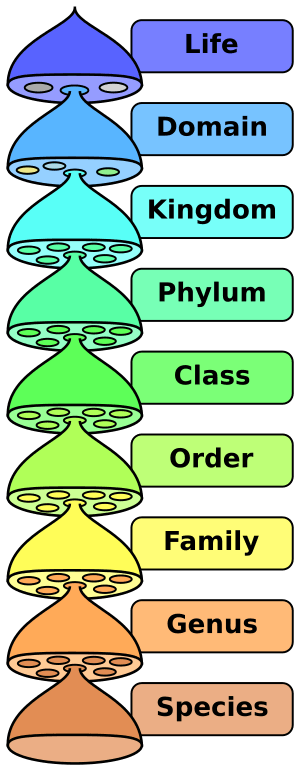Family (biology) facts for kids
In biology, a family is a way to group living things together. Think of it like a big family tree for plants and animals! Each family contains one or more genera (which is the plural of genus). The next bigger group after a family is called an order.
Usually, the name of an animal family ends with "idae," like Felidae for cats. For plants, family names often end with "aceae", like Rosaceae for roses. Sometimes, there are even smaller groups within families called subfamilies, which end with "inae" for animals or "oideae" for plants. There can also be superfamilies, which are groups of families.
In Latin, the word for family is "familia." For example, walnut trees (from the genus Juglans) and hickory trees (from the genus Carya) both belong to the same walnut family, which is called the Juglandaceae.
Contents
What is a Family in Biology?
A family is a special level in the system scientists use to classify all living things. This system helps us understand how different plants, animals, and other organisms are related to each other. It's like sorting your toys into different boxes based on what they are.
How Scientists Group Life
Scientists use a system called taxonomy to organize living things. A family is one of the main groups in this system. It sits between a genus (a smaller group) and an order (a larger group).
- Species: The most specific group, like a house cat.
- Genus: A group of very similar species, like all types of cats (lions, tigers, house cats).
- Family: A group of related genera, like all types of cats (Felidae family) and dogs (Canidae family).
- Order: A group of related families, like all meat-eating mammals (Carnivora order).
- Class: A group of related orders, like all mammals (Mammalia class).
- Phylum: A group of related classes, like all animals with backbones (Chordata phylum).
- Kingdom: A very large group, like all animals (Animalia kingdom).
- Domain: The biggest group, like all living things with cells that have a nucleus (Eukaryota domain).
Why are Families Important?
Grouping organisms into families helps scientists study them better. It shows how different groups of animals or plants have evolved from common ancestors. It also makes it easier to identify new species and understand their place in the natural world.
How are Biological Families Named?
The names of biological families follow specific rules, which helps scientists around the world understand each other.
Naming Animal Families
For animals, the name of a family usually ends with the letters "idae." This ending is added to the root of the name of one of the main genera within that family.
- For example, the family that includes all types of cats (like lions, tigers, and house cats) is called Felidae. This comes from the genus Felis (which includes house cats).
- The family for dogs, wolves, and foxes is called Canidae, from the genus Canis.
Naming Plant Families
For plants, the names of families typically end with "aceae."
- The rose family is called Rosaceae, from the genus Rosa.
- The sunflower family is called Asteraceae, from the genus Aster.
Subfamilies and Superfamilies
Sometimes, scientists need even more specific or broader groups:
- Subfamilies: These are groups within a family. Their names usually end with "inae" for animals and "oideae" for plants. For example, within the Felidae (cat) family, there's the subfamily Felinae (small to medium-sized cats) and Pantherinae (big roaring cats like lions and tigers).
- Superfamilies: These are groups of related families. Their names often end with "oidea" for animals. For example, the superfamily Hominoidea includes humans, apes, and their extinct relatives.
Examples of Biological Families
Let's look at a few examples to understand families better.
The Walnut Family (Juglandaceae)
This plant family includes trees that produce nuts.
- The genus Juglans includes all the different types of walnut trees.
- The genus Carya includes all the different types of hickory trees.
Even though walnuts and hickories look a bit different, they share enough common features to be grouped together in the Juglandaceae family. They both have compound leaves and produce nuts inside a husk.
The Cat Family (Felidae)
This animal family includes all types of cats, from the smallest domestic cat to the largest lion.
- The genus Felis includes domestic cats and some wildcats.
- The genus Panthera includes lions, tigers, leopards, and jaguars.
All these animals share key features like being skilled hunters, having retractable claws (most of them), and similar body structures, which is why they are in the same family.
The Dog Family (Canidae)
This family includes dogs, wolves, foxes, and coyotes.
- The genus Canis includes domestic dogs, wolves, and coyotes.
- The genus Vulpes includes foxes.
Members of the Canidae family are known for their strong sense of smell, endurance, and often living in social groups.
See also
 In Spanish: Familia (biología) para niños
In Spanish: Familia (biología) para niños


